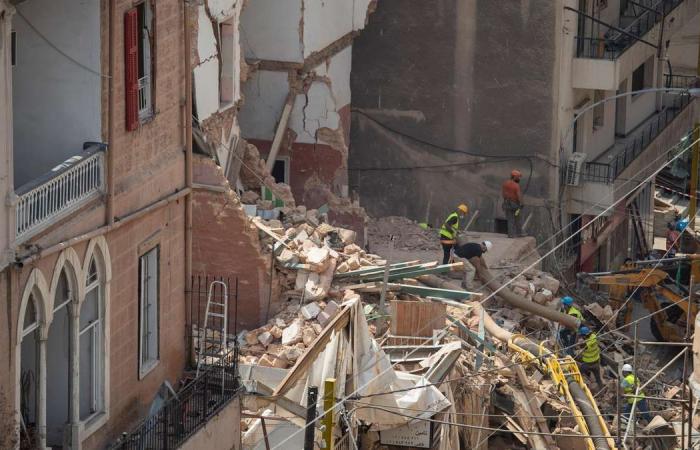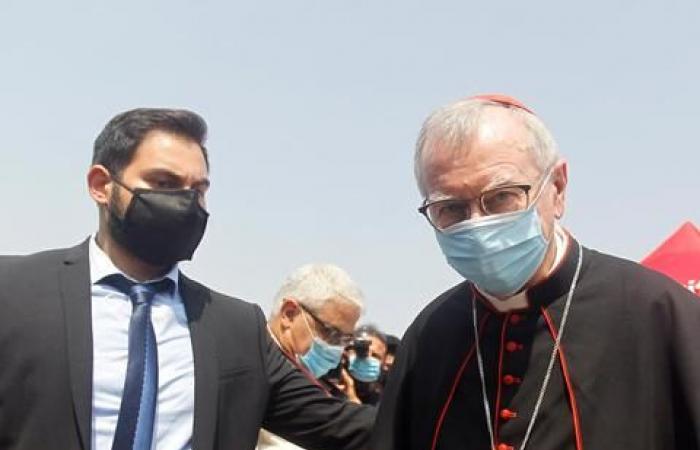Thank you for your reading and interest in the news Hope fades in Beirut as search for blast survivors drags on and now with details
Hind Al Soulia - Riyadh - Hopes of finding survivors in a building destroyed by the Beirut port blast a month ago faded on Saturday after more than 12 hours without signs of life amid the rubble.
Rescuers continued to carefully clear debris from the collapsed four-storey building in the Gemmazyeh district despite finding nothing in the locations pinpointed by sensors that detect pulse and breathing.
Riad Al Assaad, a civil engineer leading volunteers working alongside Lebanese Civil Defence and a specialist team from Chile, said the last sign of life was at 10.30pm on Friday, when sensors picked up the sound of breathing at 17 breaths per minute.
“Till now there is nothing,” Mr Al Assaad told The National on Saturday afternoon. He said the searchers were now working down through the third level of the building even though no signs of life were detected in this area.
“The machines and dog and thermal cameras have always located the first and second roof and stairways. The third roof – we had nothing there. Nevertheless we'll go to the end of our capabilities and remove the third roof.”
The search was launched after a rescue dog with the Chilean team indicated on Wednesday night that there might be people trapped in the rubble. The Chilean team said that they believed that one small sized person, maybe a child, was still alive, while a larger person was dead.
The country has watched anxiously since a delicate clearing operation began on Thursday, waiting anxiously for some good news after the August 4 explosion at Beirut port that added to the trauma of Lebanon’s worst economic crisis and the coronavirus pandemic.
The blast killed at least 190 people, left thousands injured and more than 300,000 left homeless as large areas of the capital were destroyed.
"I still want to believe in this even though I know that the chances are slim," Oscar-nominated director Nadine Labaki told The National on Friday.
She said had remained at the building site overnight since Thursday to make sure the rescue effort continued uninterrupted.
"We are attached to this small glimmer of hope. We all need to believe that better days are ahead of us," she said.
Vatican Secretary of State Italian Cardinal Pietro Parolin (R) visits the harbor area that was damaged following a huge explosion that rocked the city in Beirut, Lebanon. According to Lebanese Health Ministry, at least 190 people were killed, and more than six thousand injured in the Beirut blast that devastated the port area on 04 August and believed to have been caused by an estimated 2,750 tons of ammonium nitrate stored in a warehouse. EPA
Yukie Mokuo, UNICEF Representative to Lebanon speaks during a press conference after one month of a huge explosion that rocked the city in Beirut, Lebanon. UNICEF declared that urgent action and increased support are vital to ensure that all children affected by the Beirut explosions can access education when the new school year starts later this month, one month after two massive explosions tore through the city. At least 163 public and private schools were damaged by the explosions impacting over 70,000 students and 7,600 teachers. In addition, 20 TVET (Technical and Vocational Education and Training) schools were damaged, impacting approximately 7,300 students. According to Lebanese Health Ministry, at least 190 people were killed, and more than six thousand injured in the Beirut blast that devastated the port area on 04 August and believed to have been caused by an estimated 2,750 tons of ammonium nitrate stored in a warehouse. EPA
Rescue workers use a crane to lift concrete slabs from a destroyed building as they search for survivors in Beirut, Lebanon. A sniffer dog with a Chilean rescue crew responded to the presence of a person in the rubble of a building damaged in the deadly explosion on August 4. The condition of the person is unknown. Getty Images
Flash, a Chilean rescue dog that located the first signs that there may be a survivor of the Beirut blast trapped in a destroyed home, sits resting in Beirut, Lebanon. Flash, a sniffer dog with a Chilean rescue crew responded to the presence of a person in the rubble of a building damaged in the deadly explosion on August 4. The condition of the person is unknown. Getty Images
A Chilean rescue worker uses a sensitive listening device to locate vital signs of a survivor at a site of the Beirut blast in Beirut, Lebanon. A sniffer dog with a Chilean rescue crew responded to the presence of a person in the rubble of a building damaged in the deadly explosion on August 4. The condition of the person is unknown. Getty Images
Rescue workers use a crane to lift concrete slabs from a destroyed building as they search for survivors in Beirut, Lebanon. A sniffer dog with a Chilean rescue crew responded to the presence of a person in the rubble of a building damaged in the deadly explosion on August 4. The condition of the person is unknown. Getty Images
Rescue workers prepare to use a tube to vacuum debris from a badly damaged building in Lebanon's capital Beirut, in search of possible survivors from a mega-blast at the adjacent port one month ago, after scanners detected a pulse. Lebanese rescuers scoured rubble for a possible survivor in Beirut after the detection of a pulse drew crowds hopeful of a miracle one month on from a devastating explosion. AFP
Rescue team search through rubble of buildings damaged due to the massive explosion at Beirut's port area, in Gemmayze, Lebanon. REUTERS
Bystanders gather as rescue workers dig through the rubble of a badly damaged building in Lebanon's capital Beirut, in search of possible survivors from a mega-blast at the adjacent port one month ago, after scanners detected a pulse. Lebanese rescuers scoured rubble for a possible survivor in Beirut after the detection of a pulse drew crowds hopeful of a miracle one month on from a devastating explosion. AFP
Rescue workers dig through the rubble of a badly damaged building in Lebanon's capital Beirut, in search of possible survivors from a mega-blast at the adjacent port one month ago, after scanners detected a pulse. Lebanese rescuers scoured rubble for a possible survivor in Beirut after the detection of a pulse drew crowds hopeful of a miracle one month on from a devastating explosion. AFP
Rescue workers prepare to use a tube to vacuum debris from a badly damaged building in Lebanon's capital Beirut, in search of possible survivors from a mega-blast at the adjacent port one month ago, after scanners detected a pulse. Lebanese rescuers scoured rubble for a possible survivor in Beirut after the detection of a pulse drew crowds hopeful of a miracle one month on from a devastating explosion. AFP
A rescue worker chains concrete to a crane while trying to find a survivor of the Beirut blast in Beirut, Lebanon. A sniffer dog with a Chilean rescue crew responded to the presence of a person in the rubble of a building damaged in the deadly explosion on August 4. The condition of the person is unknown. Getty Images
Mr Al Assaad said searching the remaining level of the building would be “very tricky” because part of the building structure was resting on a wooden window frame and could collapse.
“We are afraid that this wooden jamb (window) might crack,” he said.
“So what we'll do is that we'll either instigate a failure or we'll prop and go up and do scaffolding or temporary support and take the building down.”
He said signals detected on Friday had raised false hopes that survivors might be found on higher levels or under an external staircase at the side of the building.
“We cleared the second roof all the way around 8.30pm. Two people from civil defense thought they heard vibration. We stopped and did another doppler. It said nothing. Yet we continued to clear the second roof.
“The Chileans did their recalibration. They were telling us (bodies) were 1.9 to 2 metres below the rubble. If we cleared the rubble there was no depth other than the stairway
“So they concentrated on the stairs. On the upper level they thought they could hear breathing so they had to act fast. So we started today at 9. We cleared the stairs and there was nothing there. What remains is the third roof.”
Lebanese officials had played down the chances of anyone surviving so long beneath the rubble.
Chilean specialist Walter Munoz put the chances of finding a survivor at "two per cent".
"Always in search operations like this, you can neither lose hope nor absolutely say there is hope," George Abou Moussa, director of operations in Lebanon's civil defence, told Reuters.
"The building is really crumbling, it's scary and there's a lot of danger to the team," Mr Abou Moussa said.
Workers were using shovels and their hands to dig, while mechanical diggers and a crane lifted heavy debris.
Emmanuel Durand, a French civil engineer who was training local university students, volunteered his services and was working with the rescuers to monitor the structure.
Scanning the building with high-precision lasers, Mr Durand said his team had so far not found any signs of movement.
Updated: September 5, 2020 09:32 PM
These were the details of the news Hope fades in Beirut as search for blast survivors drags on for this day. We hope that we have succeeded by giving you the full details and information. To follow all our news, you can subscribe to the alerts system or to one of our different systems to provide you with all that is new.
It is also worth noting that the original news has been published and is available at The National and the editorial team at AlKhaleej Today has confirmed it and it has been modified, and it may have been completely transferred or quoted from it and you can read and follow this news from its main source.


